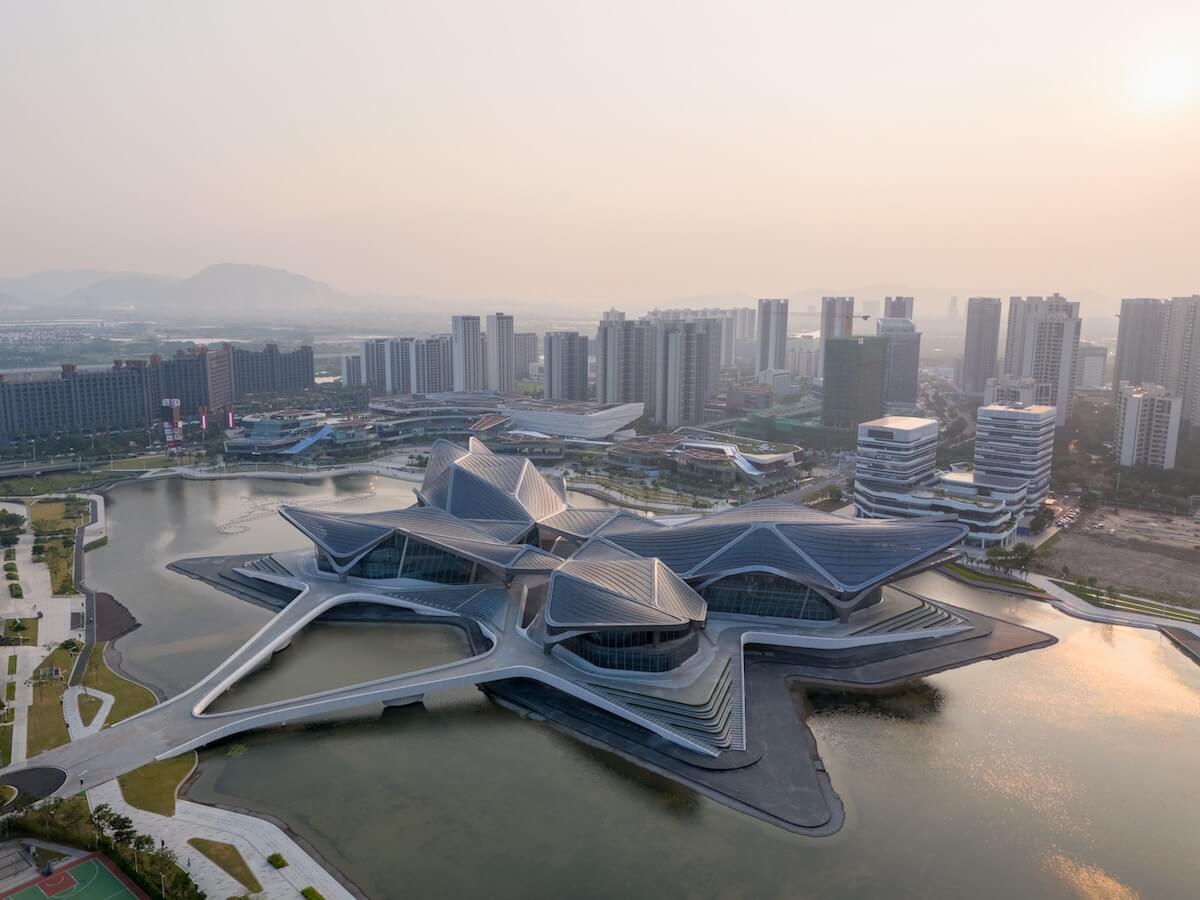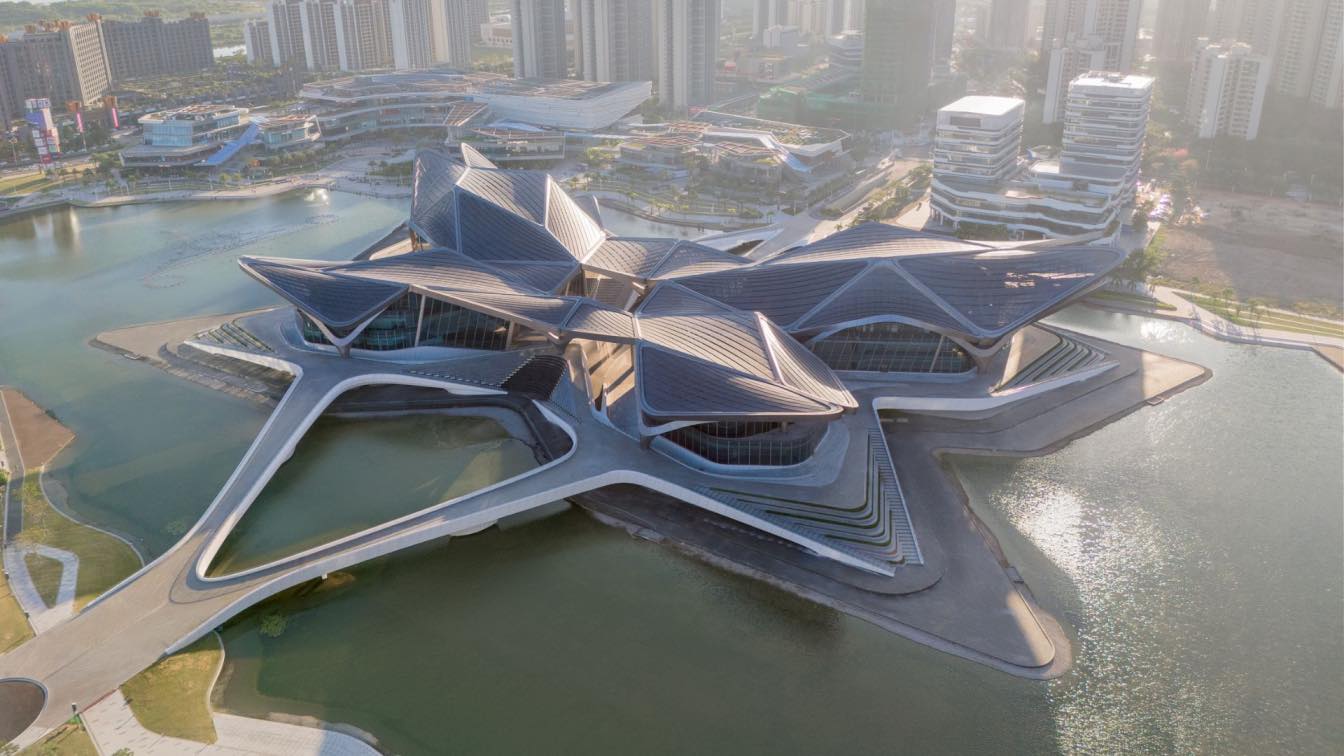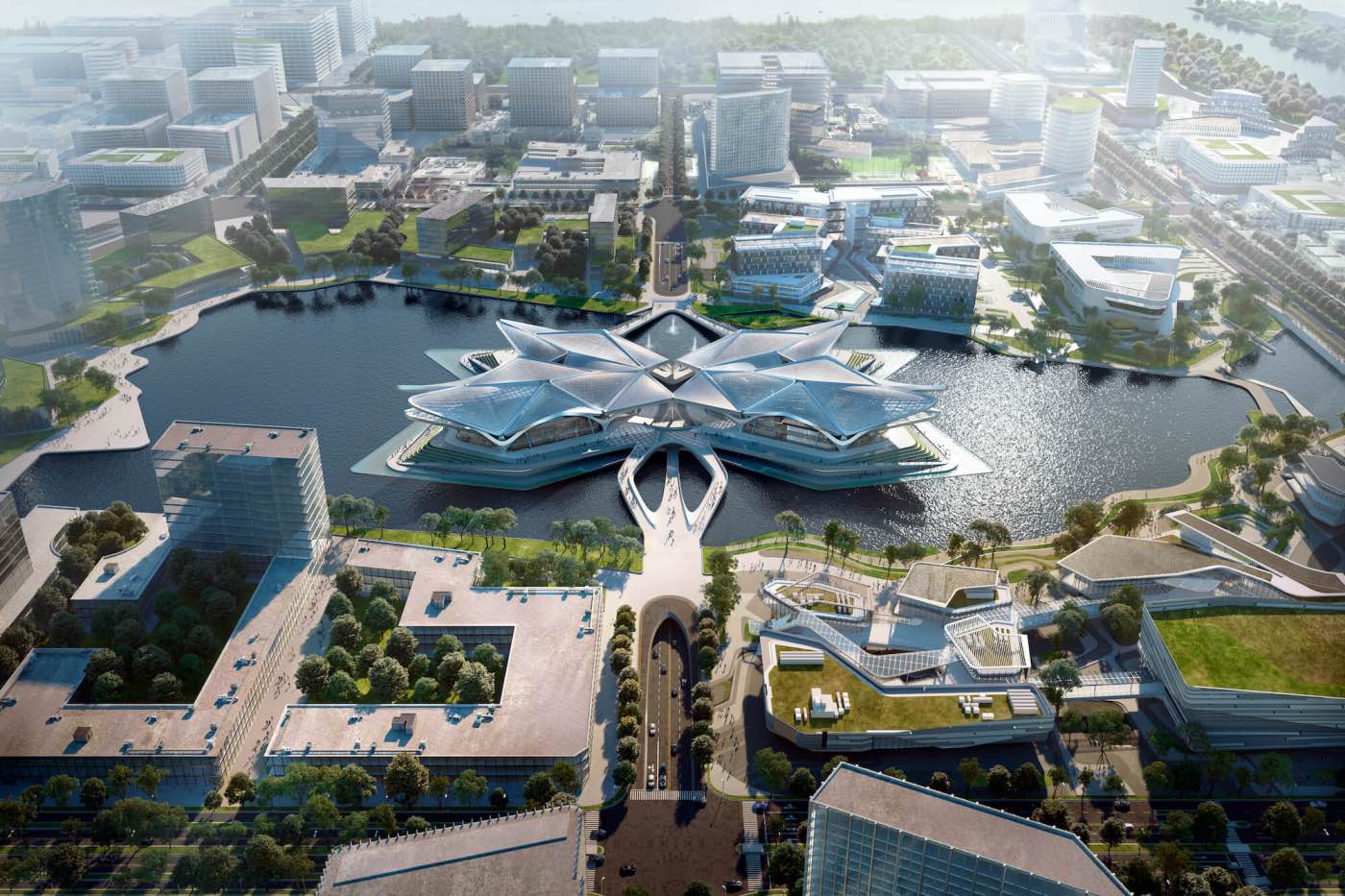Zaha Hadid Architects: Designed as a hub of contemporary creativity within one of the world’s most dynamic regions, the Zhuhai Jinwan Civic Art Centre is at the heart of Aviation New City, an urbanisation with a built area of 4.78 million sq. m housing 100,000 residents and incorporating new civic, cultural, academic and commercial infrastructure within Zhuhai’s Jinwan district. The Zhuhai Airport Railway, an extension of the Guangzhou-Zhuhai Intercity Railway, provides direct connections with Zhuhai’s city centre and its airport, while the new Hong Kong-Zhuhai-Macau bridge enables those in Shenzhen and Hong Kong to reach Zhuhai in less than an hour.
Integrating three distinct cultural institutions for the city (a Performing Arts Centre with a 1200-seat Grand Theatre and a 500-retractable-seat multifunctional Black Box theatre; an interactive Science Centre; and an Art Museum) each venue within the Zhuhai Jinwan Civic Arts Centre incorporates unique characteristics that create differing visitor experiences, yet all are united by a coherent formal and structural logic that spans 170 meters wide from east to west and 270 meters long from north to south.
Arranged symmetrically on a central axis, the two larger and two smaller venues are connected by a central plaza that serves as a shared external foyer to all of the cultural institutions. Glazed walls facing this courtyard enable visitors to determine the individuality and character of each venue. The Grand Theatre and Art Museum are finished in a light palate of materials, while the multifunctional Black Box Theatre and Science Centre are composed in darker materials.

Echoing the chevron patterns of migratory birds flying in formation over southern China, the latticed steel canopies sheltering each venue are configured through repetition, symmetry and scale variation; resulting in a composition of related elements that respond to the different functional requirements of each building. This repetition of the self-supporting and self-stabilising roof modules optimised pre-fabrication, pre-assembly and the use of modular construction.
The distinctive roof structure unites the different venues under a network of reticulated shells that envelop the four wings of the centre. Interconnecting bridges and voids create a multi-layered public plaza at the heart of the centre with views to the interiors as well as to the surrounding promenades with their cafés, restaurants and educational facilities. The design optimizes intuitive navigation with natural light in all public areas to enhance connectivity; creating engaging civic spaces for local residents to enjoy throughout the day and evening.
The Grand Theatre’s interior continues the composition of the centre’s external roof canopy with the location and angle of ceiling panels optimised as sound reflectors. The Grand Theatre’s sound absorbing surfaces are designed to meet the highest acoustic standards required for local, national and international performances.
The Art Museum adapts the chevron geometries of the roof to frame the main atrium which provides natural light to the museum while at the same time creating a continuous vertical surface to display artworks. An internal gallery, storage and administrative spaces are located behind this vertical division. Merging architecture with exhibition experience, a continuous white ‘ribbon’ of museum’s vertical circulation and exhibition route is its’ defining feature.

The Science Centre’s interior also translates the geometry of the centre’s roof to showcase scientific innovation with interactive exhibits that inspire curiosity and learning. The Science Centre’s lecture hall is designed for the centre’s programme of public demonstrations of scientific experiments and discovery.
Zhuhai Jinwan Civic Art Centre’s podium defines an island within ZhongXin Lake. Pedestrian ramps and tunnels invite visitors to cross the lake’s surface to the podium’s central public plaza where footbridges connect through voids to each venue. Glazed façades sheltered by the modular roof canopy provide transparency and welcome the local community onto lakeside boardwalks and plazas beneath the sweeping roof structure. An external amphitheatre on the west side of the centre allows for outdoor performances and activities.
Constructed in concrete, the centre consists of five structurally separate buildings, each with its own self-supporting external steel canopy. Supported by only 22 columns and spanning a total of 270m x 170m, these free-formed steel roof canopies are composed of symmetrical geometries to enable their modular, repetitive structures to be fabricated off-site and assembled from only two different column types.
The centre’s landscaping and surrounding lake are designed as integral elements within Zhuhai’s ‘sponge city’ initiative that targets the natural permeation, storage and re-use of at least 70% of the city’s rainwater using aquatic flora and fauna to naturally filter contaminants. Humidity and soil-moisture sensors within the landscaping’s irrigation system control and reduce water consumption.

Located within the subtropical climate of coastal southern China, the double-insulated glazing of the building’s envelope is optimized for thermal performance and protected by the latticed roof canopy which incorporates perforated aluminium panels for external solar shading. The perforations within the panels vary in size to allow differing degrees of sunlight within the centre’s interior spaces in accordance to their programming requirements, orientation and solar gain. At night, this roof canopy bathes the centre in soft reflected light.
Energy consumption and indoor air quality monitoring systems with intelligent control will automatically adjust the centre’s interior environments for optimal comfort and energy reduction. Waste heat recovery will be used to meet the centre’s hot water demand with water-saving appliances connected to the centre’s water recycling system. Designed to meet the highest tiers of China’s Green Building Evaluation Standards, the selection and procurement of the centre’s structural components has prioritized recycled steel, aggregates and other component materials.















Project Team
Architect/建筑单位: Zaha Hadid Architects (ZHA)ZHA Design Principal/设计总裁: Zaha Hadid and Patrik SchumacherZHA Project Directors/项目总监: Satoshi Ohashi, Charles WalkerZHA Project Associate Directors/项目高级经理: Lydia Kim, Yang JingwenZHA Project Associates/ 项目建筑师: Mei-Ling Lin, Aurora Santana (SD)ZHA Project Leads/项目负责人: Mei-Ling Lin, Elena ScripellitiZHA Project Core Team/项目核心团队: Armando Bussey, Reza Karimi, Julian LinZHA Project CA Team/项目现场团队: Qi Cao, Kai-Jui Tsao, Mei-Ling Lin, Juan Liu, Yuling Ma, Feifei Fan
ZHA Project Team/项目团队: Armando Bussey, Marius Cernica, Grace Chung, Nelli Denisova, XuexinDuan, Kaloyan Erevinov, Nassim Eshaghi, Kate Hunter, Yang Jingwen, Reza Karimi, Ben Kikkawa,Lydia Kim, Julian Lin, Mei-Ling Lin, Valeria Mazzilli, Sareh Mirseyed Nazari, Massimo Napoleoni,Satoshi Ohashi, Yevgeniya Pozigun, Qi Cao, Qiuyu Zhao, Aurora Santana, Hannes Schafelner, MichaelSims, Patrik Schumacher, Sharan Sundar, Maria Touloupou, Chao Wei, Charles Walker, Kai-Jui Tsao,Yuling Ma, Feifei Fan
ZHA Competition Team/参赛团队: Armando Bussey, Clara Martins, Cristiano Ceccato, Charles Walker,Ed Gaskin, Filippo Nassetti, Jinqi Huang, Juan Liu, Lydia Kim, Julian Lin, Satoshi Ohashi, Paulo Flores,Harry Spraiter, Patrick Schumacher, Houzhe Xu, Simon Yu
CONSULTANTS/顾问团队:
本地设计院:北京市建筑设计研究院有限公司华南设计中心Local Design Institute: Beijing Institute of Architecture & Design South China Centre结构顾问:北京市建筑设计研究院有限公司华南设计中心Structural Consultant: Beijing Institute of Architecture & Design South China Centre绿建顾问:广东卓骏绿色建筑科技有限公司Green Building Consultant: Guangdong JORJUN Green Building TechnologyBIM顾问: 北京数字营国信息技术有限公司BIM Consultant: Beijing BIMTechnologie幕墙顾问: 珠海市红海幕墙有限公司Façade Consultant: Zhuhai City Honghai Curtain Wall泛光设计: 深圳市全局照明科技有限公司Lighting Consultant: Shenzhen Global Lighting Technology景观顾问: 北京市建筑设计研究院有限公司华南设计中心Landscape Consultant: Beijing Institute of Architecture & Design (South China Centre)舞台工艺顾问: 上海德已工程技术有限公司Theater Consultant: Shanghai DeYi Engineering Technology标识顾问: 深圳市幻影视觉广告公司Signage Consultant: W&T Design消防顾问: 北京市建筑设计研究院有限公司华南设计中心Fire Consultant: Beijing Institute of Architecture & Design (South China Centre)音视频顾问: 中广电广播电影电视设计研究院Amplify Consultant: Radio, Film & TV Design and Research Institute声学顾问: 华东建筑设计研究院有限公司_声学及剧院专项设计研究所Acoustic Consultant: East China Architectural Design & Research Institute (Acoustic & TheatreSpecial Design & Research Division)精装顾问: 深圳市中孚泰文化建筑建设股份有限公司Interior Consultant: Shenzhen Z&F Culture Construction
CONTRACTORS/承建单位:总包: 中冶城市投资控股有限公司General Contractor: MCC City Investment Holding幕墙承建方: 深圳市三鑫科技发展有限公司Façade Contractor: Shenzhen Sanxin Technology Development景观承建方: 珠海五岳园林景观工程有限公司Landscape Contractor: Zhuhai Wuyue Landscape Engineering室内承建方: 深圳市维业装饰集团股份有限公司Interior Contractor: Shenzhen Weiye Decoration Group





